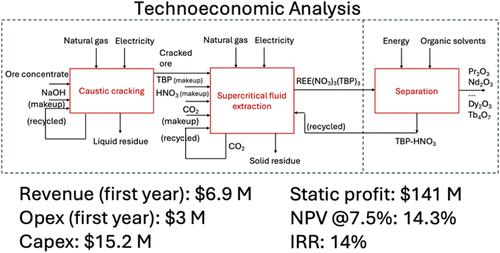Technoeconomic Analysis of the Supercritical Fluid Extraction Process for the Extraction of Rare Earth Elements from Ores
IF 3.9
3区 工程技术
Q2 ENGINEERING, CHEMICAL
引用次数: 0
Abstract
This study investigates the technoeconomic feasibility of utilizing supercritical fluid extraction (SCFE) with supercritical CO2 and a tributyl phosphate–nitric acid (TBP-HNO3) adduct for recovering rare earth elements (REEs) from the complex zircon-rich mineral concentrate. A detailed technoeconomic analysis (TEA) framework is employed, integrating mass and energy balance calculations, economic modeling, scenario evaluation, and sensitivity analysis. The research aims to establish the economic viability and scalability of SCFE technology as a sustainable alternative to conventional extraction methods. The study focused on an industrial-scale facility in Ontario, Canada, equipped with a 4000 L SCFE reactors. Key findings included first-year operational expenditures approaching 3 million USD and total capital expenditures of 13.7 million to 14.6 million USD. Revenue from the extracted REEs varied, with the highest returns associated with high-value elements such as terbium and dysprosium. Sensitivity analysis highlights that the profitability of the process is most sensitive to REE prices, particularly for Nd2O3, Dy2O3, and Tb4O7, followed by reagent costs and utility expenses. Payback periods ranged from 6.9 years in the optimal scenario to 12.8 years in less favorable configurations. This study demonstrates the potential of SCFE as a viable technology for REE recovery, emphasizing the importance of feedstock optimization, cost-effective reagent usage, and scalability.

超临界流体萃取法从矿石中提取稀土元素的技术经济分析
研究了利用超临界CO2和磷酸三丁酯-硝酸(TBP-HNO3)加合物超临界流体萃取法从某复杂富锆精矿中回收稀土元素的技术经济可行性。采用详细的技术经济分析(TEA)框架,将质量和能量平衡计算、经济建模、情景评估和敏感性分析集成在一起。该研究旨在建立SCFE技术的经济可行性和可扩展性,作为传统提取方法的可持续替代方案。这项研究集中在加拿大安大略省的一个工业规模的设施上,该设施配备了一个4000升的SCFE反应堆。主要发现包括第一年的运营支出接近300万美元,总资本支出为1370万至1460万美元。稀土开采的收益各不相同,收益最高的是高价值元素,如铽和镝。敏感性分析表明,该工艺的盈利能力对稀土价格最为敏感,尤其是Nd2O3、Dy2O3和Tb4O7,其次是试剂成本和公用事业费用。投资回收期从最理想情况下的6.9年到较不利情况下的12.8年不等。这项研究证明了SCFE作为一种可行的稀土回收技术的潜力,强调了原料优化、低成本试剂使用和可扩展性的重要性。
本文章由计算机程序翻译,如有差异,请以英文原文为准。
求助全文
约1分钟内获得全文
求助全文
来源期刊

Industrial & Engineering Chemistry Research
工程技术-工程:化工
CiteScore
7.40
自引率
7.10%
发文量
1467
审稿时长
2.8 months
期刊介绍:
ndustrial & Engineering Chemistry, with variations in title and format, has been published since 1909 by the American Chemical Society. Industrial & Engineering Chemistry Research is a weekly publication that reports industrial and academic research in the broad fields of applied chemistry and chemical engineering with special focus on fundamentals, processes, and products.
 求助内容:
求助内容: 应助结果提醒方式:
应助结果提醒方式:


